LP114b
Location: Natte Yallock
Aust. Soil Class.: Vertic (& Hypercalcic), Mesonatric, Brown SODOSOL
General Site Description: Plains near small tributary of Bet Bet Creek.
Geology: Basalt (Quaternary)
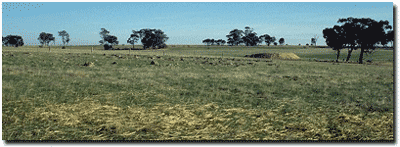 Site LP114 Soil Landscape |
Soil Profile Morphology:
| Surface Soil | 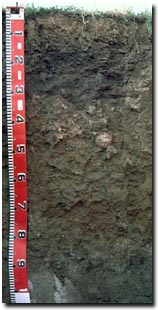 Site LP114b Soil Profile | ||
| A1 | 0-10 cm | Dark yellowish brown (10YR3/4), fine sandy clay loam; moderate medium sized blocky structure; very firm consistence (dry); pH 6.1; abrupt change to: | |
| A2 | 10-25 cm | Dark reddish brown (5YR2.5/2) conspicuously bleached (5YR7/1), fine sandy clay loam; moderate medium sized blocky structure, parting to strong fie blocky structure; pH 6.3; clear change to: | |
| A3 | 25-40 cm | Dark brown (10YR4/3) with 25% strong brown (7.5YR5/8) and 10% greyish brown (10YR5/2), fine sandy clay loam; very firm consistence (moist); pH 8.4; clear change to: | |
| Subsoil | |||
| B21 | 40-60 cm | Dark yellowish brown (10YR4/4), medium clay; firm consistence (moist); slickensides present; pH 8.4; abrupt change to: | |
| B22 | 60-80 cm | Strong brown (7.5YR4/6), medium heavy clay; strong consistence (moderately moist); few (2%) hard carbonate nodules; occasional basalt cobbles (up to 100 mm diameter); pH 8.7; abrupt change to: | |
| B23 | 80-140 cm | Greyish brown (10YR5/2), medium clay; firm consistence (moderately moist); moderately calcareous; pH 9.1. | |
Key Profile Features:
- Strong texture contrast between surface (A) horizons and upper subsoil (B21) horizon.
- Conspicuously bleached subsurface (A2) horizon.
pH | Salinity Rating | |||
Surface (A1 horizon) | Slightly Acid | Very Low | Marginally Sodic | None 1 |
Subsoil (B21 horizon) | Moderately Alkaline | Slight | Strongly Sodic | Strong |
Deeper subsoil (at 85+ cm) | Very Strongly Alkaline | Medium | Strongly Sodic | Slight |
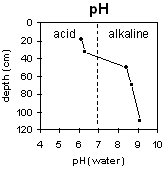 | 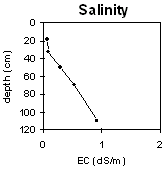 | 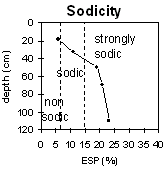 | 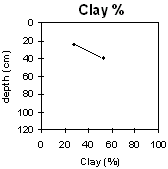 |
Horizon | Horizon Depth | pH (water) | pH CaCl2 | EC dS/m | NaCl % | Exchangeable Cations | Ex Al mg/kg | Ex Ac meq/100g | Field pF2.5 | Wilting Point pF4.2 | Coarse Sand (0.2-2.0mm) | Fine Sand (0.02-0.2mm) | Silt (0.002-0.02mm) | Clay (<0.002mm) | |||
Ca | Mg | K | Na | ||||||||||||||
meq/100g | |||||||||||||||||
A1 | 10-25 | 6.1 | 4.9 | 0.08 | 6.2 | 4 | 0.67 | 0.61 | 32.7 | 13.8 | |||||||
A2 | 25-40 | 6.3 | 4.9 | 0.1 | 4.9 | 5.1 | 0.47 | 1.3 | 27.8 | 12.6 | 5 | 45 | 21 | 28 | |||
A3 | 40-60 | 8.4 | 7.1 | 0.29 | 9.4 | 13 | 1.1 | 5.3 | 45.2 | 23.9 | 3 | 30 | 11 | 53 | |||
B21 | 60-80 | 8.7 | 7.8 | 0.53 | 0.13 | 10 | 16 | 1.2 | 7 | ||||||||
B22 | 80-140 | 9.1 | 8.4 | 0.92 | 0.08 | 19 | 25 | 1 | 13 | ||||||||
Surface (A) Horizons
- The bleached subsurface (A2) horizon indicates that periodic waterlogging occurs on top of the more slowly permeable subsoil. This horizon is likely to become 'spewy' as a result.
- The level of the organic carbon indicates that the organic matter of the surface soil is low. Organic matter is important for reducing slaking and enhancing soil aggregation, fertility and water holding capacity. Organic matter levels will build up under pasture but will decline if cultivation takes place. Practices such as residue retention, minimum tillage and including pasture rotations should be utilised if cropping occurs.
- The surface horizons are dispersive after remoulding. This indicates that the surface soil will disperse when worked in a moist condition even though it may not disperse in its natural state. The action of rain impact on the soil surface may also cause dispersion; by maintaining some pasture or stubble cover this may be prevented. Tillage or over-stocking should be avoided when the soil is in a moist to wet condition.
- The dense and coarsely structured subsoil is sodic and dispersive (and has a low calcium:magnesium ratio). This will result in restricted root and water movement in the subsoil. Water is likely to build up on the top of the subsoil after heavy rains causing waterlogging of the more porous surface horizons.
- The salinity rating is of the soil from 60 cm is medium to high. This may affect the growth of some deeper-rooted salt sensitive plant species.


